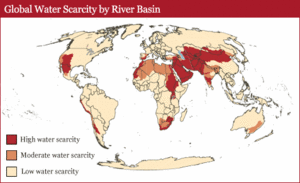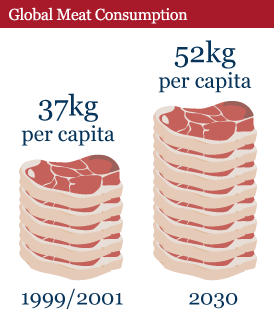85% of the world population lives in the driest half of the planet.
 783 million people do not have access to clean water and almost 2.5 billion do not have access to adequate sanitation.
783 million people do not have access to clean water and almost 2.5 billion do not have access to adequate sanitation.
6 to 8 million people die annually from the consequences of disasters and water-related diseases.
Various estimates indicate that, based on business as usual, ~3.5 planets Earth would be needed to sustain a global population achieving the current lifestyle of the average European or North American.
Global population growth projections of 2–3 billion people over the next 40 years, combined with changing diets, result in a predicted increase in food demand of 70% by 2050.
Over half of the world population lives in urban areas, and the number of urban dwellers grows each day. Urban areas, although better served than rural areas, are struggling to keep up with population growth (WHO/UNICEF, 2010).
With expected increases in population, by 2030, food demand is predicted to increase by 50% (70% by 2050) (Bruinsma, 2009), while energy demand from hydropower and other renewable energy resources will rise by 60% (WWAP, 2009). These issues are interconnected – increasing agricultural output, for example, will substantially increase both water and energy consumption, leading to increased competition for water between water-using sectors.
Water availability is expected to decrease in many regions. Yet future global agricultural water consumption alone is estimated to increase by ~19% by 2050, and will be even greater in the absence of any technological progress or policy intervention.
 Water for irrigation and food production constitutes one of the greatest pressures on freshwater resources. Agriculture accounts for ~70% of global freshwater withdrawals (up to 90% in some fast-growing economies).
Water for irrigation and food production constitutes one of the greatest pressures on freshwater resources. Agriculture accounts for ~70% of global freshwater withdrawals (up to 90% in some fast-growing economies).
Economic growth and individual wealth are shifting diets from predominantly starch-based to meat and dairy, which require more water. Producing 1 kg of rice, for example, requires ~3,500 L of water, 1 kg of beef ~15,000 L, and a cup of coffee ~140 L (Hoekstra and Chapagain, 2008). This dietary shift is the greatest to impact on water consumption over the past 30 years, and is likely to continue well into the middle of the twenty-first century (FAO, 2006).
About 66% of Africa is arid or semi-arid and more than 300 of the 800 million people in sub-Saharan Africa live in a water-scarce environment – meaning that they have less than 1,000 m3 per capita (NEPAD, 2006).
Source: http://www.unwater.org/
Dear User/Visitor! Please, answer on our questions: tick off one of the positions – your answer will make us able to improve our site and make it more interesting and useful!

